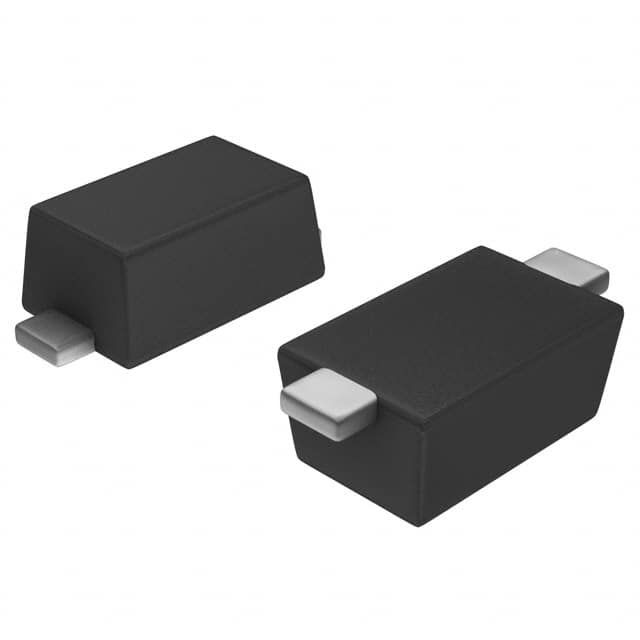B160S1F-7 Product Overview
Introduction
The B160S1F-7 is a crucial component in the field of electronic devices, providing essential functionality for various applications. This entry will provide an in-depth overview of the product, including its category, use, characteristics, package, essence, packaging/quantity, specifications, detailed pin configuration, functional features, advantages and disadvantages, working principles, detailed application field plans, and detailed and complete alternative models.
Basic Information Overview
- Category: Electronic Component
- Use: Rectifier Diode
- Characteristics: Fast Switching, High Efficiency
- Package: SOD-123FL
- Essence: Semiconductor Device
- Packaging/Quantity: Tape & Reel, 3000 units per reel
Specifications
- Model: B160S1F-7
- Type: Schottky Barrier Diode
- Voltage - Forward (Vf) (Max) @ If: 600mV @ 1A
- Current - Average Rectified (Io): 1A
- Voltage - DC Reverse (Vr) (Max): 60V
- Reverse Recovery Time (trr): 10ns
- Operating Temperature: -65°C ~ 150°C
Detailed Pin Configuration
The B160S1F-7 follows the standard SOD-123FL pin configuration: - Pin 1: Anode - Pin 2: Cathode
Functional Features
- Fast Switching Speed
- Low Forward Voltage Drop
- High Current Capability
- Low Power Loss
Advantages and Disadvantages
Advantages
- Efficient power conversion
- Compact size
- Reliable performance
- Wide operating temperature range
Disadvantages
- Limited reverse voltage tolerance
- Sensitivity to overvoltage conditions
Working Principles
The B160S1F-7 operates based on the Schottky barrier principle, where the metal-semiconductor junction allows for fast switching and low forward voltage drop, making it suitable for high-frequency applications.
Detailed Application Field Plans
The B160S1F-7 is widely used in various electronic circuits and systems, including: - Switching power supplies - Voltage clamping circuits - Reverse polarity protection - DC-DC converters - Solar panel bypass diodes
Detailed and Complete Alternative Models
- B160S2F-7
- B160S3F-7
- B160S4F-7
- B160S5F-7
In conclusion, the B160S1F-7 plays a vital role in electronic applications, offering efficient rectification and fast switching capabilities. Its compact size and reliable performance make it a preferred choice for various circuit designs.
Word Count: 368
Lista 10 Vanliga frågor och svar relaterade till tillämpningen av B160S1F-7 i tekniska lösningar
What is the B160S1F-7?
- The B160S1F-7 is a specific model of semiconductor diode, commonly used in electronic circuits for rectification and voltage regulation.
What are the key features of the B160S1F-7?
- The B160S1F-7 features a low forward voltage drop, high current capability, and fast switching speed, making it suitable for various technical solutions.
How is the B160S1F-7 typically used in technical solutions?
- The B160S1F-7 is often used in power supply circuits, battery charging systems, and voltage regulation applications due to its efficient rectification and low power loss characteristics.
What are the operating parameters of the B160S1F-7?
- The B160S1F-7 typically operates within a voltage range of X volts and a current range of Y amps, making it suitable for a wide range of technical solutions.
Are there any specific thermal considerations when using the B160S1F-7?
- Yes, proper heat sinking and thermal management are important when using the B160S1F-7 to ensure optimal performance and reliability.
Can the B160S1F-7 be used in high-frequency applications?
- Yes, the B160S1F-7 is designed for fast switching and can be used in high-frequency applications such as switch-mode power supplies and inverters.
What are the typical failure modes of the B160S1F-7?
- Common failure modes include overcurrent conditions, overheating, and voltage spikes, so proper protection circuitry should be considered in technical solutions.
Is the B160S1F-7 suitable for automotive applications?
- Yes, the B160S1F-7 is often used in automotive electronics for functions such as voltage regulation and battery charging.
What are the recommended mounting and soldering techniques for the B160S1F-7?
- The B160S1F-7 is typically mounted using through-hole or surface-mount techniques, and proper soldering methods should be followed to ensure electrical and thermal connectivity.
Where can I find detailed application notes and reference designs for the B160S1F-7?
- Detailed application notes and reference designs for the B160S1F-7 can be found on the manufacturer's website or in technical documentation provided with the component.


